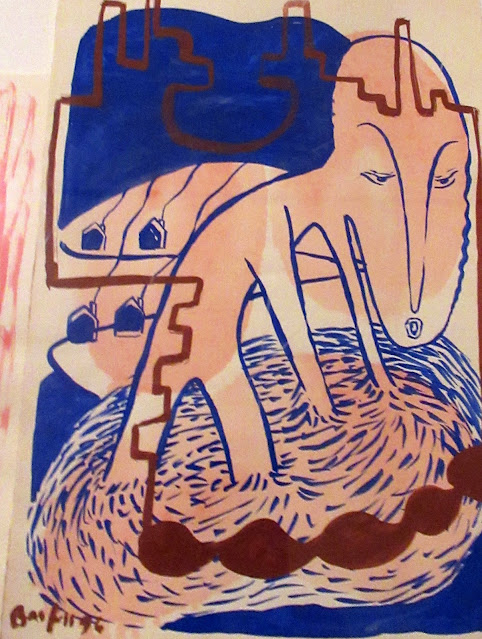at the Ashmolean, Oxford.

A.R. Penck, The Problems of England (northern Darkness IV), 1987, (emulsion paint and synthetic resin on canvas)
A.R. Penck, Night Vision, 1982, (woodcut)
Luciano Castelli, Untitled, 1988, (gouache and chalk)
Elvira Bach, Untitled, 1980
Markus Lupertz, Landscape, 1998, (lithograph)
George Baselitz, Sea Eagle, 2000, (etching and aquatint)
Georg Baselitz, Otto Piedi, (Eight Feet), 2000, (etching and drypoint)
Georg Baselitz, A Fascist Flew Past, 1998, (etching)
The 1980s saw an international revival of painting in expressive, gestural styles. The works are often colourful, figurative, experimental and energetic, and contrast with the then dominant trend of conceptual and minimal art. This new artistic movement was soon called 'Neo-Expressionism'. It was particularly prominent in Germany, where the Expressionism art movement had originated in the early 20th century. West Berlin artists worked with diverse artistic materials and found inspiration in urban subcultures, like in Punk or in the gay scene. Their art became known internationally as of 1981 and within a very short period of time.

This energetic painting suggesting human encounters, action and conflict can be related to violent incidents in England, and the bombings and armed confrontations of the Troubles in Northern Ireland. The work was created after Penck's Northern Darkness solo exhibition, which was shown in Derry, Dublin and Edinburgh. The abstracted, simplified visual language and the animals depict battles as timeless phenomena of society.
These woodcuts that the artist made a few years after he was expatriated from East Germany and had moved to West Germany give an idea of Penck's life-long interest in the Stanart stick man figure. Although the posture of the figure often remains the same - standing still while raising his arms - the focus of each work is different: the compositions range from static to dynamic, from archetypal to ornamental, and the stick men range from detailed figures to radically reduced geometric forms.
A.R. Penck, Berlin Suite, 1990, (aquatint)
This series of prints comprises scenes inspired by the artist's experiences in West Germany. The images range from a saxophone player, who might relate to the artist's own band activities, to a tiger and abstract stick men. Black outlines are floating rhythmically on colour fields. The bright primary colours convey a feeling of happiness and hope in Berlin, following the end of the Cold War.
This energetic drawing of a nude couple in front of a colourful abstract background exemplifies Luciano Castelli's fascnation with naked bodies and bright colours.
Rainer Fetting, Portrait of Shaun, 1989, (3 etchings)
These portrait etchings created in New York not only represent Fetting's artistic interest in the male (often black) nude as an erotic subject but they also show his experimental approach to printing, exploring the same motif in different colours. Fetting had moved to New York in 1983 after becoming known internationally with expressive-figurative paintings as one of the most important protagonists in the 'Junge Wilde' in West Berlin.
This image of an inverted eagle is highly representative of Baselitz's work. The artist works on his paintings and prints upside down. He has maintained this practice since 1969, to concentrate on foral structure rather than literal content. The eagle is a key motif in his oeuvre - in the quest for pure and non-representational art, it is shown as an abstracted bird rather than a traditional German symbol ingrained in his country's complex national consciousness.
Eight feet in high heels, four of them upside down, convey a feeling of dynamic movement. The motif of feet has been recurring in Baselitz's oeuvre since the 1960s - it is often linked to his autobiographical experiences, such as fleeing during WWII as a child from Dresden to the village of Deutschbaselitz. But here, the women's legs contrasting against a bright yellow background suggest a sense of rhthm and dance.
Georg Baselitz, A Fascist Flew Past, 1998, (etching)




















No comments:
Post a Comment